Mystery Solved: British Man Identified After 12 Years Thanks to Cutting-Edge DNA Technology

A poignant mystery has finally been resolved thanks to advancements in DNA technology. Michael Hill, a 75-year-old British citizen, remained unidentified for over a decade following his death in the United States. Now, he has become the first British national to be identified through a groundbreaking new DNA analysis method, bringing closure to what must have been a deeply unsettling situation.
The case highlights the remarkable progress being made in forensic science and the potential for these technologies to reunite families and solve long-standing cold cases. For years, authorities struggled to ascertain Hill’s identity, leaving his remains in a state of uncertainty. Traditional methods of identification proved unsuccessful, leaving investigators with few leads.
The breakthrough came with the implementation of a new DNA analysis technique. This advanced method, details of which are still being closely guarded to prevent misuse, was able to extract and analyze genetic material from the remains, ultimately leading to a match within existing databases. The precise nature of the technology is significant; it's reportedly more sensitive and capable of handling degraded DNA samples than previous methods, making it particularly effective in cases where time has taken its toll.
A First for British Nationals
Hill's identification marks a significant milestone – he is the first British citizen to be identified through this innovative DNA analysis in the US. This underscores the growing collaboration between international law enforcement agencies and the adoption of advanced forensic techniques across borders. It is hoped that this success will pave the way for similar identifications in other cases involving unidentified remains, both in the UK and abroad.
The Human Cost of Unidentified Remains
Beyond the technical details, this story carries a profound human element. The lengthy period of uncertainty must have been agonizing for any potential family members who may have been searching for Hill. The identification provides a sense of closure, allowing them to grieve properly and finally lay him to rest. It also serves as a stark reminder of the importance of accurate identification procedures and the need for ongoing investment in forensic science.
Looking Ahead: The Future of DNA Identification
This case exemplifies the transformative power of DNA technology in modern investigations. As the technology continues to evolve, we can expect even more sophisticated methods to emerge, capable of identifying individuals from increasingly limited samples. This will undoubtedly have a significant impact on law enforcement, helping to solve crimes, identify missing persons, and bring closure to countless families. The use of AI and machine learning in conjunction with DNA analysis is also expected to accelerate identification processes further in the future.
Authorities are now working to notify any potential relatives of Michael Hill and provide them with the information they need to begin the grieving process. This case stands as a testament to the enduring power of science and the unwavering dedication of those who work to bring answers to those left behind.






